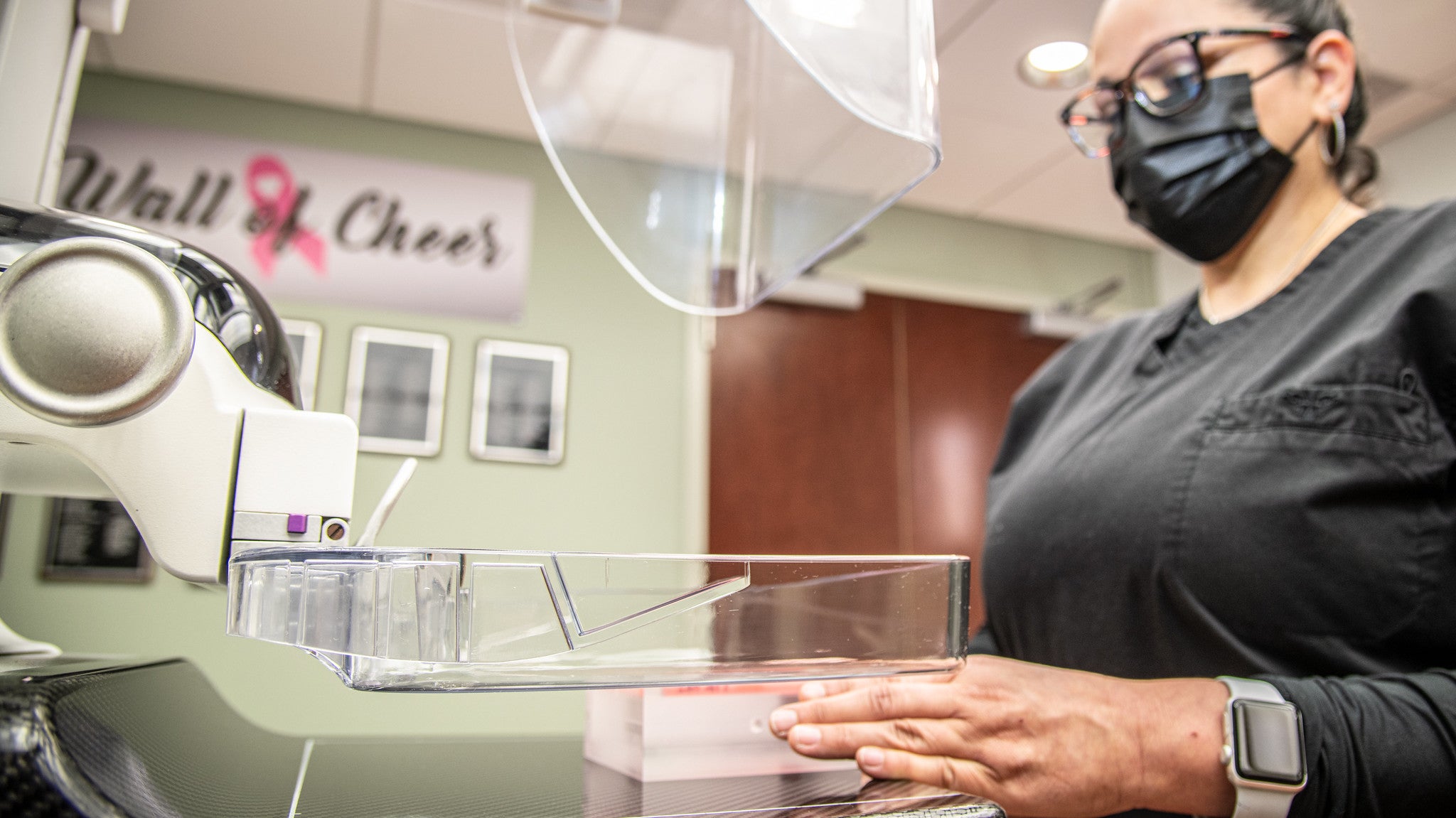A relatively new approach to paying for basic health care services, one in which patients pay a recurring membership fee to a doctor rather than having insurance pay costs for routine tests and treatment, is attracting growing interest and raising questions, including in Wisconsin.
It’s called direct primary care, and there is scant data about the health and economic benefits of this approach compared to those of the prevailing insurance-centered health care system.
Stay informed on the latest news
Sign up for WPR’s email newsletter.
But physicians who practice within and advocate for this model see it as an opportunity to make health care more efficient and spend more time with their patients and less doing insurance paperwork.
Wisconsin hasn’t adopted state laws specifying how direct primary care should be regulated, what scope of services a direct primary care doctor should offer, how a direct primary care agreement differs from health insurance, or whether direct primary care practices can bill Medicare and Medicaid. The state Legislature considered a direct primary care proposal in its 2017-18 session. The Assembly passed a bill (AB 798) in February 2018, but it died in the state Senate (SB 670) in March. The proposal would have exempted direct primary care providers from state insurance regulations, but would have enabled the Wisconsin Department of Health Services to investigate complaints about them. The proposal would have also ordered the agency to create a way for Medicare, Medicaid or BadgerCare recipients to use direct primary care services.
Since the failure of that proposal, Wisconsin legislators have convened a study committee to provide information that might inform any future policy moves addressing direct primary care. And as state lawmakers and regulators consider what to do, they’ll enter a nascent policy landscape dealing with a model that’s still finding a place within a rapidly shifting healthcare landscape. The first states to pass laws addressing direct primary care were West Virginia (2006) and Washington (2007), and at least 25 states in total have passed or at least considered legislation to regulate and/or encourage its practice.
A breadth of legislation gives Wisconsin an assortment of examples to look to as lawmakers consider how to regulate the model. But all in all, these policies haven’t been in place for very long, which makes it all the more difficult for health policy researchers to gauge their effectiveness.
Varying approaches at the state level
As the name implies, a direct primary care agreement mostly provides a patient access to basic family-doctor-type services, though practices might offer a different range of services and have disparate approaches to referring patients out to specialists for non-primary-care treatment — from surgery to medical imaging to physical therapy. These patients will generally need what’s known as a “wrap-around” health insurance policy to cover what the direct primary care provider doesn’t do as part of the membership agreement.
Direct primary care advocates argue that the model’s limited scope is a good thing, and that health insurance should just be for the big, catastrophic stuff. Still, this approach runs counter to the prevailing insurance-centered model of healthcare in the United States.
In order to reconcile these different structures, healthcare providers and policymakers have to grapple with a number of questions. What kind of insurance, if any, should direct primary care patients be required to have? Should direct primary care practices be able to bill Medicare and Medicaid, and if so, how should they be integrated into the broader framework of public health insurance? How should direct primary care doctors coordinate with specialists outside of their own practices? What sorts of preventative care should direct primary care doctors be required to provide?
States with direct primary care laws differ widely in how they integrate the model into the larger health system. At least two states (Louisiana and Washington) allow health insurance companies to reimburse direct primary care clients for their subscriptions. Some states allow (Louisiana, West Virginia) and forbid (Mississippi, Texas) direct primary care providers to bill Medicaid. In most states with specific regulations, direct primary care doctors are barred from billing insurance companies for services, but that is not the case in Arkansas, Missouri and Oklahoma. Other states, including West Virginia, Michigan and Nebraska are in various stages of creating pilot programs to serve uninsured people or Medicaid recipients who purchase direct primary care.
Most state laws addressing the model deliberately specify that a direct primary care agreement is not an insurance policy. Advocates for direct primary care like this approach, because it exempts such practices from the purview of state-level insurance regulators. Meanwhile, one opponent of direct primary care has called the model “essentially unregulated insurance” that lacks patient protections.
In many states, existing laws do place direct primary care in relatively lightly regulated territory. And because researchers have gathered so little solid evidence of direct primary care’s health and economic outcomes, legislators and regulators in individual states don’t have a lot of information to help guide their policy choices. Instead, they’ll be hearing mostly from direct primary care doctors who advocate for the model, or from opponents in the medical and public-health communities — though even some skeptics see promise in its approach to working with patients.
Oregon has some of the most extensive and explicit rules surrounding direct primary care. A state law enacted there in 2011 declares that direct primary care isn’t insurance, but explicitly gives the state the authority to regulate, investigate and even shut down practices that work within the model. The law creates other broad requirements, for instance that these practices “must provide only primary care and must limit the scope of services provided or the number of patients served to an amount that is within the capacity of the practice to provide in a timely manner.”
A wariness of regulation
People in the health care community who are wary of direct primary care see Oregon’s approach as a step in the right direction. The advocacy group Direct Primary Care Frontier, on the other hand, calls Oregon “easily the worst of all states.” The group declares a 2016 statute passed by Wyoming, which exempts direct primary care from insurance regulations and requires doctors to be up-front about the fact that these agreements are not insurance but pretty much leaves it at that, to be “the best DPC law on the books!”
The healthcare community isn’t necessarily anti-regulation. In fact, groups like the American Medical Association have spoken out in favor of the Affordable Care Act and other large-scale efforts to regulate care and/or insurance. But the direct primary care movement strikes a distinctly libertarian tone, or at least some of the voices driving the conversation do.
One of the model’s most prominent advocates, Kansas physician Dr. Joshua Umbehr, has run for office as a Libertarian, and media outlets and pundits with a libertarian point-of-view, like Reason, have held up direct primary care as a way for market forces and the doctor-patient relationship to reclaim control of healthcare from government and the insurance industry. Another prominent advocate, Philip Eskew, who is founder of Direct Primary Care Frontier, is also affiliated with the libertarian Heartland Institute. (Eskew didn’t respond to WisContext’s calls for comment.) In Wisconsin, the conservative MacIver Institute has touted the model’s cost-savings in La Crosse.
Another group advocating for the model, the Direct Primary Care Coalition, shows some openness to regulation in a model bill on its website. The language in this bill, like many existing state laws, largely focuses on distinguishing direct primary care from health insurance. It also offers patients at least a modicum of protection against doctors turning them away due to pre-existing conditions, stating: “Direct primary care practices may not decline to accept new direct primary care patients or discontinue care to existing patients solely because of the patient’s health status.”
Overall, Direct primary care doctors and their supporters generally discourage policymakers from what they consider over-regulation of the model. Advocates argue that mechanisms already in place — including malpractice insurance policies, medical licensure, and state and federal consumer-protection laws — already do enough to codify the doctor-patient relationship and protect patients’ medical and financial rights.
“I think you’ll find a lot of opinions,” said Jay Keese, a Washington, D.C.-based lobbyist who represents the Direct Primary Care Coalition, referring to the policy approaches supporters would like to see. “I don’t think anybody in this movement has ever gone in and tried to change any of the regulations that are already in place and well-founded to regulate the practice of medicine.”
Making it all fit together
Direct primary care providers must think about how their services connect with all the other things a patient might need that’s outside the scope of their practice. Some of these doctors offer a catastrophic coverage policy along with the recurring direct primary care membership fee, and set up different methods for consulting with specialists, including through medical e-consulting services or networking with more comprehensive health care systems in their area. Some provide different forms of preventative care.
The relative blank slate of the model could allow some direct primary care doctors to offer more than a conventional practice currently might.
“One of the things that’s been the most fun for us is to bring things back into primary care that had been farmed out,” said Dr. LuAnn Moraski, a physician with the Your MD direct primary care practice in Mequon.
Moraski said it makes sense for primary care practices to cross over into what the healthcare industry tends to consider specialties, like OB-GYN care and dermatology, and also sees opportunities to give patients easier access to medical devices. Her practice lends nebulizers to patients suffering asthma problems on short notice, for example. In a conventional practice that bills insurance, it would take about an hour’s worth of paperwork to get an insurer to approve a take-home nebulizer for a patient, Moraski said, and cutting that out means someone in respiratory distress can get quicker relief.
But the model could also give direct primary care practices an incentive to limit the services they provide, Northeastern University professor of business and health policy Timothy Hoff argued in a September 2018 op-ed for the health care news outlet STAT.
“While insurance companies spread their financial risk across large numbers of patients and many different doctors and practices, the direct primary care doctor or practice can spread it only over a limited number of patients,” Hoff explained. “That imposes significant pressure to keep service utilization, care management activity, and direct contact per patient lower to maximize the profit margin.”
The Affordable Care Act plays a role with direct primary care as well, even as opponents in states, Congress and the Trump administration pursue its dismantling.
The law directly mentions direct primary care: “The Secretary of Health and Human Services shall permit a qualified health plan to provide coverage through a qualified direct primary care medical home plan that meets criteria established by the Secretary, so long as the qualified health plan meets all requirements that are otherwise applicable and the services covered by the medical home plan are coordinated with the entity offering the qualified health plan.”
This language broadly suggests that insurers and doctors should work to pair direct primary care agreements with more inclusive insurance plans, but it gives individual states a lot of discretion as to the specifics. Jay Keese, who represents the Direct Primary Care Coalition, praises this provision, saying it opens the door for more doctors to offer direct primary care, and for states to craft policies that make sense for their residents’ needs.
One of the greatest barriers to regulating the model effectively is that there is not really such thing as a conventional direct primary care practice.
Keese said that as more businesses (especially large companies) explore direct primary care agreements as part of their employee health care packages, it will push practices to develop more standardized, scalable approaches. Medicare and Medicaid reimbursement requirements would add to that pressure as well.
This growth sets up a bit of a paradox: Flexibility and openness to innovation is supposed to be the very thing that separates direct primary care from insurance-driven healthcare delivery, but if the model catches on too fast, it could lose its openness and flexibility. For the moment, though, Keese thinks direct primary care is growing at a healthy pace that still gives doctors room and time to experiment.
“We’re not close to being too big too fast,” he said.
But this pace leads to another paradox. In order to regulate direct primary care effectively, policymakers may first have to leave still more room for experiments, in order for providers to create best practices and standards that can help guide regulations.
At least, that’s how Moraski sees it. She doesn’t favor extensive regulations beyond the consumer and patient protections already on the books in Wisconsin, though she said that laws that ensure transparency and full disclosure would best serve both patients and doctors. For the most part, Moraski thinks the model still needs as much leeway as possible in order to define itself.
“The problem with standardization is, what are you standardizing to?” Moraski said.
Making policy in a shifting landscape
A central challenge for policymakers is figuring out where direct primary care doctors’ responsibilities should begin and end, and how to make sure that their patients have adequate access to all the medical services that practice doesn’t or can’t provide.
Currently in Wisconsin, there’s no requirement or any one standard for direct primary care doctors to connect their clients to specialized or other additional services. The language of the state’s unpassed direct primary care bill didn’t create many specific requirements for direct primary care providers or direct the Department of Health Service to create regulations around the model. It also wouldn’t have created any specific requirements for direct primary care patients to get wrap-around insurance, though it would have required direct primary care providers to state, “in writing, that the agreement is not health insurance and that the agreement alone may not satisfy individual or employer insurance coverage requirements under federal law.”
All of this comes as the United States has a fierce, drawn-out debate over how to reduce healthcare costs and how to regulate healthcare and health insurance at the federal level. Even if Congressional Republicans and the Trump administration continue to deliberately chip away at the interdependent pieces of the Affordable Care Act, private insurance policies still need a wide pool of patients in order to keep their costs in check. The ACA does broadly permit direct primary care coverage, as long as it’s coupled with an insurance policy that covers other medical services.
As state regulations stand now, though, “it is not currently possible in Wisconsin to purchase a (qualified health plan) in conjunction with a DPC agreement without having duplication in coverage,” according to a policy brief the University of Wisconsin-Madison Population Health Institute prepared for the state legislative committee studying the model.
The U.S. Justice Department has declared its intentions to not defend the ACA’s individual mandate, and a major federal tax law passed in 2017 eliminated the ACA’s tax penalty for not having insurance, a change that will take effect in 2019.
Some states have moved to create their own individual mandates. But those states will inevitably face court challenges, and the federal judiciary under the Trump administration is becoming more conservative, and therefore, more likely to oppose the ACA. This landscape provides an incentive for patients, especially younger and healthier people, to sign on to a direct primary care plan and not bother with “wraparound” insurance to cover everything else. It’s a dynamic that could effectively take a lot of healthier people out of insurance risk pools, increasing the cost of conventional health insurance for people who remain on it. Ultimately, it would debilitate the ACA, which is essentially predicated on as many people as possible being in insurance pools, spreading out the costs of care.
Policymakers looking at direct primary care will also have to reconcile it with the concept upon which much of the U.S. healthcare system, including Medicare and Medicaid, is built — one in which centralized systems like insurance and large healthcare providers work to coordinate different kinds of medical care in the interests of profit and efficiency. It’s a model broadly known as “managed care.”
Managed care falls short for patients in a variety of ways — the U.S. has the highest health care costs in the world, and even after the implementation of the ACA, millions of Americans still lack adequate access to care. But because the managed care model is foundational to the contemporary U.S. health system, anyone hoping to grow a new model will have to contend with it.
“Most care delivery occurs through integrated delivery systems,” said Donna Friedsam, an adviser to the Legislature’s direct primary care study committee and health policy programs director at the UW Population Health Institute.
“Primary care does not stand alone,” Friedsam added. “It’s part of a continuous care delivery with other providers … almost all Medicaid providers are part of a managed care system. The question is how much these providers are going to coordinate their care.”
Concerns about patient protection, effectiveness
The kinds of laws direct primary care advocates are pushing for might leave patients without anyone in state government to turn to if they have a complaint, said Maanasa Kona, a professor at Georgetown University’s Center on Health Insurance Reforms.
“Without state oversight, it is impossible to know the extent to which [direct primary care agreements] might be engaged in health status underwriting in order to minimize their insurance risk, cherry picking healthy members, or otherwise able to cover costs without exposing consumers to unexpected financial liabilities,” Kona wrote in a February 2018 post on the Center’s blog.
Without strong state oversight, Kona told WisContext, it’s also hard for lawmakers and regulators to keep track of whether direct primary care doctors are marketing their offerings as alternatives, rather than supplements, to conventional health insurance.
“I think that states should ensure that they have mechanisms in place to not let direct primary care be an alternative to health insurance,” Kona said. “They should try and have laws in place and make sure that direct primary care is combined with health insurance and that people are adequately covered for an eventuality, and that just because the individual mandate is gone they’re not going to end up choosing DPC as an alternative.”
States also should keep track of how practices using the model are managing their money and taking on risk, Kona added.
Direct primary care advocates have argued that systems already built into the medical world, like professional licensing for doctors, and market forces like competition and patients exercising their choices as consumers, will keep the model honest. For instance, Wisconsinites who currently have problems with a doctor or health care facility can complain to the Wisconsin Department of Safety and Professional Services or the Wisconsin Department of Health Services.
But such agencies have different kinds of expertise and experience than state bodies that oversee insurance, like the Wisconsin Office of the Commissioner of Insurance. If direct primary care exists in a bit of a gray area — an individual doctor providing something that aims to supplement or replace insurance — then it’s policymakers will be faced with the question of which, if any, of these agencies is best equipped to regulate the model in the public interest.
Dr. Paul George, a Brown University physician and professor who co-authored a July 2018 Journal of the American Medical Association article critical of the direct primary care model, said that without adequate regulations, direct primary care could create a two-tiered health care system in the United States.
“I think it creates a situation that is ripe for abuse, quite honestly,” George said. “You’re sort of charging an individual an extra fee … on top of folks having to buy health insurance.”
While George concedes that the direct primary care model can improve satisfaction for both doctors and patients, he also pointed out that satisfaction and health outcomes are not the same. In George’s view, direct primary care still needs to make its case to consumers.
“If direct primary care practices want to make a claim that they’re improving health care, that they’re improving primary care, then they need to prove it,” George said. “They need to report their outcomes.”
How Should Wisconsin Regulate Direct Primary Care? was originally published on WisContext which produced the article in a partnership between Wisconsin Public Radio, Wisconsin Public Television and Cooperative Extension.
This report was produced in a partnership between Wisconsin Public Radio, PBS Wisconsin and the University of Wisconsin Cooperative Extension. @ Copyright 2024, Board of Regents of the University of Wisconsin System and Wisconsin Educational Communications Board.












